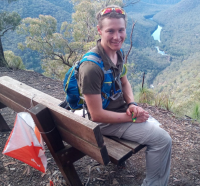
Unless you have arms like an octopus, the single most important piece of equipment to have for a rogaine is a good backpack, because without one, it is near impossible to carry the bounty of other essential gear to keep you dry, fed, warm or cool for many hours.
Just like almost every other piece of equipment used in a rogaine, there are no bags specifically manufactured for rogaining, and people have different views about what works best. I have my own two cents to add, but have enlisted the help of several rogaining long-timers. Thanks to Andrew Duerden, Gill Fowler and Pierre Francois for sharing their views and experiences.
Let’s start with me, Tristan White: I have used almost exclusively two backpacks for rogaines over the past seven or so years, both of which happened to be acquired at the (now defunct) Highland Fling MTB race. The CamelBak 2011 HAWG (Holds A lotta Water and Gear) was one of the prizes for a category win, and has probably joined me for more adventures than any other of my possessions. With two zip-up side pouches, and a bounty of pockets, it has worked for up to 24-hours of bashing around the bush without feeling too uncomfortable. Primarily made for cycling, it has also been my main bag for commuting as the pouch for the bladder perfectly fits in a small laptop.

The greatest tragedy of this item is that it’s no longer manufactured and whilst I have searched far and wide, I cannot find a replacement, leading to me rather desperately stitch together more broken seams than I can count, and also making me the subject of much ridicule as I brazenly carry the dirty and torn-up contraption around shops, airports and conference centres.
More recently, I jumped on the 50% discounted CamelBak Ultra 10 at the CamelBak display stand for the 2015 Highland Fling. It is predominately made for ultramarathons, and I’d describe it as somewhere between a vest and a backpack, something that works very well for a long rogaine where I do a combination of walking and running. It’s been great, as it’s light enough to not feel bulky when I’ve used it for a 3-hr event owing to its elasticity, but I’ve used it for almost every 24-hr event since I got it. The catch is that it usually doesn’t fit my raincoat and I generally cable tie it to the outside of the pack. Whilst Gill advises against this below, it’s worked very well for me and saved me the additional expense of a new pack.
It too has got its fair share of tears which have required some stitchwork, but is mostly still going strong from a couple dozen rogaines, trail runs and epic mountain bike rides over the years. I highly recommend something similar to relatively serious rogainers.
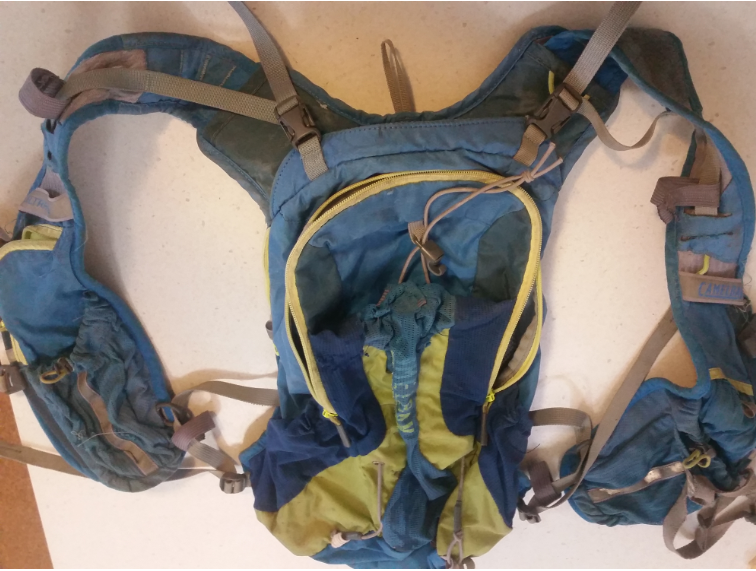
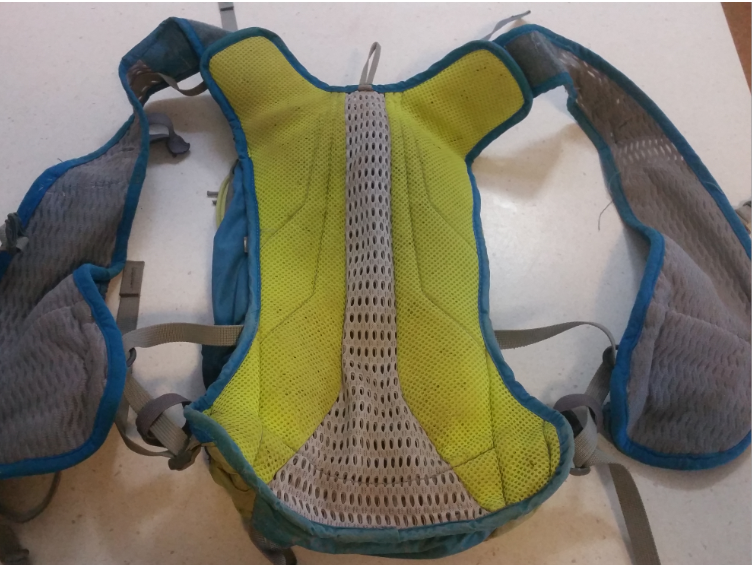
Andrew Duerden: I use the Salomon 12L ultra race vest for all rogaines and have done so for the past 5-6 years. In addition to a few ultramarathons, I have used the pack for 50+ events and numerous training runs and there is nothing wrong with it except for a small tear on the rear. I find it very comfortable in all conditions, very light, and not constrictive when running, climbing or bashing through bush. I got it at Pace in North Sydney for about $250.
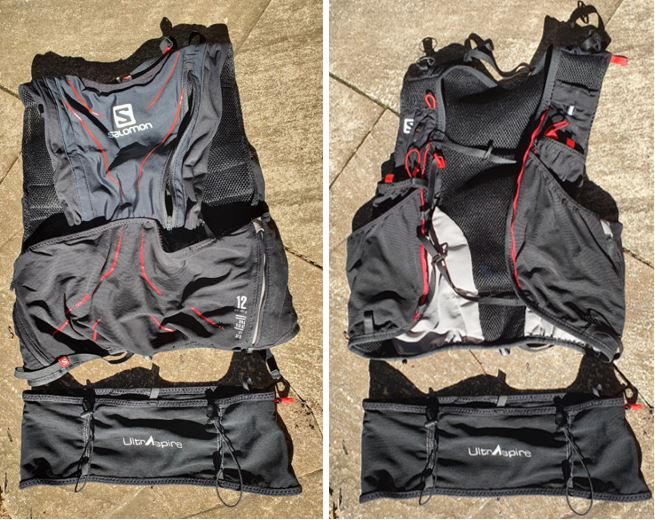
Gill Fowler: I’ve used several backpacks for rogaining. The type and size of backpack depends on the event. The size is just big enough to hold the gear I need and robust enough to withstand scrub bashing (very important!). Also it is better to have a pack that has slightly more capacity, rather than try to stuff it all in, as you want to be able to easily access your gear, and an overstuffed pack is not as comfortable. It also needs to fit your body – so trying before use is good. I tend towards a women’s specific pack, as it fits my frame better – if the harness is too big it moves around too much when I run and the outcome is chafing.
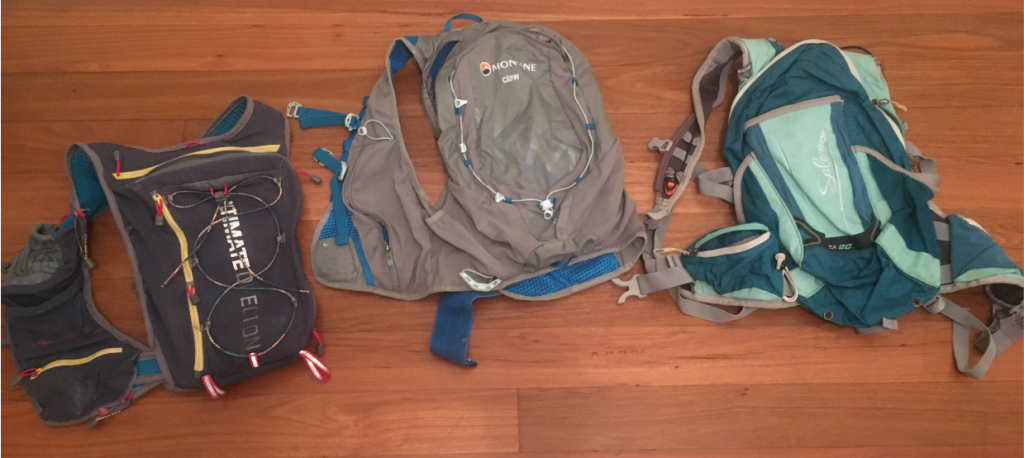
Pierre Francois: Over my eight years in rogaining I have been able to try multiple packs in terms of brand (Quechua, Salomon, Lafuma, Ultimate Direction), capacity (5L to 35L), shape (from classic hiking to racing vest), and colour (I tried them all!) I’m currently racing with an Ultimate Direction Fastpack 35 (vest style).

I went to the “vest” because I wanted to have a pack which doesn’t bounce while I run and I found vests are greatly designed for that. The second criteria for my choice was the number of pockets, as I like to have everything accessible while I run, so I don’t have to stop to open the pack and grab what I need. I counted that one has six compartments on the front and four at the back/side (that is on top of the main compartment!) In terms of capacity, I use the 35L one which is a bit of overkill for rogaining, but since I also use it for adventure racing where races go for longer and the mandatory gear is more extensive than in rogaining, they fit the purpose. I have recently purchased a 16L version which I used for the recent Nightgaine and it worked very well.
It has 11 pockets and you need to be organised to like them. I bought them from an online retail shop – runningwarehouse.com.au.

Tristan White: What are the pros and cons between a ultramarathon vest, a conventional daypack and light overnight hiking pack?
AD: I have never worn a normal pack so can’t compare.
GF: An ultramarathon vest style pack is my pick for a shorter rogaine, when you don’t need to carry much gear and you are not doing much off-track navigation – i.e. metrogaine, socialgaine and minigaine. These vests are often not as robust as other packs, so I don’t often use them for the 12 and 24-hr bush events, in which case I’m looking for a reasonably lightweight, robust and well-fitting pack, which is usually a more heavy duty running pack, adventure race style pack. But if you predominantly hike most of your rogaine events a day pack/hiking pack is fine – an overnight pack is likely too big.
PF: In my view the rule is simple: a conventional backpack will work well for hiking but won’t be great if you want to run. However, a vest will work both styles. I also find the vests are lightweight and have numerous pockets which make it very easy to grab food or gear on the go. The Ultimate Direction vests have big mesh pockets at the back which I use for almost everything.
TW: How do you fit your pack to best distribute the weight over your body, and what are common mistakes about misfitting a pack?
AD: All heavy gear (including the bladder) is placed in the rear centre compartment and in the centre of the large lower stretch pocket. This ensures there is no sideways movement. All other gear is then distributed evenly on the lower rear stretch pockets and in the front pouches. I also carry two 500ml bottles in the front two pockets. I vary the rear bladder size between 1.5L and 2L (and vary the amount in the bladder) depending on weather conditions and length of event. For shorter events (6-hr or less) I will only carry the front two 500ml bottles as these are easier to drink from when running and quicker to refill.
PF: I start first by the bladder as I found it hard to put the bladder properly while other gear is already in the back. That said, when I do refill the bladder during a course I don’t unload everything in my pack to put the bladder first 🙂 Once I have the bladder in, I will stash first the safety kit as they are the least likely to be needed (fingers crossed, although we did use it in the Nightgaine after a stick had perforated my mate’s hand) and everything else up to the top. First in means less likely needed.
TW: What is the approximate weight of your pack at the start of a 24hr event
AD: Weight is about 6.5kg and consists of:
- Race vest (300gm)
- 2L bladder full (2kg)
- 2 x 500ml soft flasks (1kg)
- Food (1.5kg)
- Head torch & batteries (350gm)
- First aid kit (200gm)
- Raincoat (300gm) and/or thermal top (200gm) – only if it is going to rain and be very cold (below 5) would I carry both
- Trekking poles (400gm)
- Phone (300gm)
GF: As light as I can make it! My best guess is less than 4kg.
PF: I am not too sure but certainly too heavy because I often start with a 3L bladder full where I could (should) have less water, presuming I could refill on the course. That’s probably an area of improvement for me.
TW: Have you made any modifications to your backpack to better fit what you carry?
AD: No modifications made to race vest.
GF: No.
PF: Not on the Ultimate Direction packs but I did repair the first few ones I had to keep them alive for years. Also on my previous one, which was a Lafuma, I did purchase small pockets, and another one which I used as a “bin” which I sewed on so I could then expand my compartment space. This is probably what triggered my wish to get a new pack with that many small pockets.
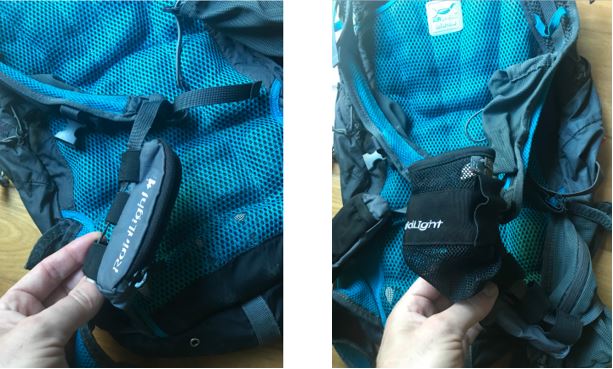
TW: How do you pack your backpack to make it as straightforward to get what you need?
AD: Food which I plan to eat during sunset/sunrise stops (for changing head torches and clothing,) along with other larger item reserve food, first aid kit, and head torch/battery are in the larger rear zip pouch and lower rear stretch pocket. Quick access food (gels/bars) is in front pouches and race belt. Trekking poles are in a special holder on rear of pack. Extra clothing in rainproof zip lock bag in reach stretch pocket.
GF: There’s lots of pockets these days on packs, but for rogaines of more than 6 hours I always have a water bladder on my back (not water flasks on the front) my gear is in back, on small dry bag with my warm clothes, another with my torch and spare battery for night. Food is in the small pockets with excess in the main bag.
PF: I try to think of what I will need while I race and will dispatch it in all the various pockets. Things like snacks will be all over my front pockets and other food or warm gear (such as arm warmers) will be in the side pocket or big mesh at the back. You need a good teammate to grab stuff for you from the mesh 🙂
TW: Do you have any strategies for waterproofing warm clothes/other items you carry?
AD: Quality zip lock bags are adequate (single or doubled up) – if it will rain then I am usually wearing a rain jacket and if forecast is for heavy rain then phone goes in a waterproof pouch.
GF: Dry bags.
PF: For emergency clothes and kit, I use small waterproof bags that you can find everywhere. For food, I will stick to traditional zip-lock bags.
Final note from Gill: Keep an eye out at the next event, and check out what bags others are using – quiz people at the HH, they may even let you try their pack on (best done at the start, before it gets caked with sweat!)